University Research Proposal: Pain Management in End-of-Life Patients
VerifiedAdded on 2020/04/01
|20
|5029
|51
Report
AI Summary
This research proposal focuses on pain management strategies for end-of-life patients, aiming to understand the attitudes and knowledge of nursing staff in this critical area of healthcare. The study begins with a comprehensive literature review, highlighting the importance of effective pain management to alleviate suffering and improve the quality of life for patients facing the end of their lives. The research will employ a qualitative methodology, using semi-structured interviews to gather in-depth insights from registered nurses in a palliative care unit. The proposal outlines the research design, participant recruitment and sampling, data collection methods, data analysis techniques, and ethical considerations. The goal is to identify current practices, challenges, and potential improvements in pain management to enhance the care provided to elderly patients at the end of their lives. The study emphasizes the need for nurses to be well-informed about pain management strategies, including the use of analgesics and other pain relief methods, and addresses the barriers that may hinder effective pain management. The research question centers on the attitudes of nursing staff towards pain management during the end of life, with the aim of contributing to improved patient outcomes and better support for healthcare professionals.
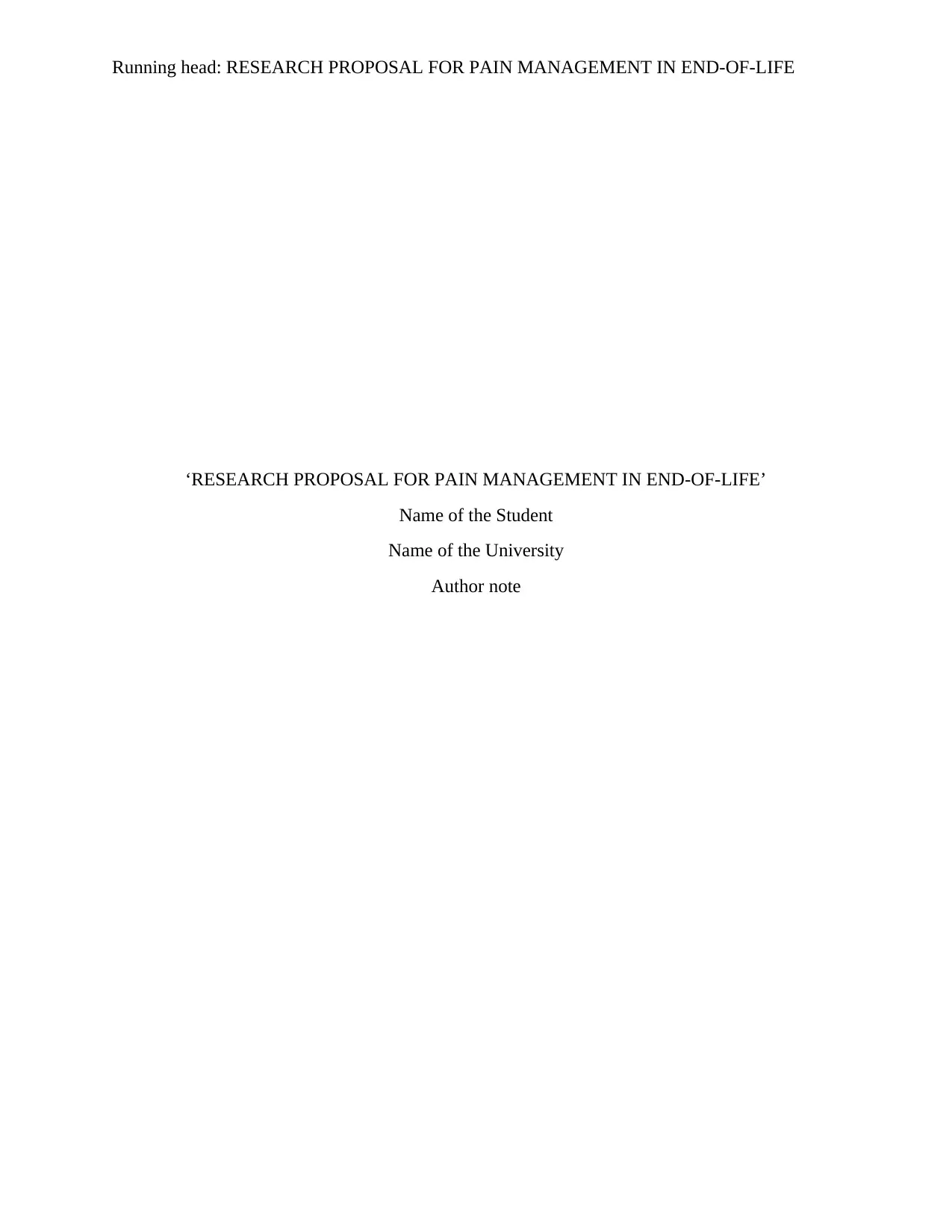
Running head: RESEARCH PROPOSAL FOR PAIN MANAGEMENT IN END-OF-LIFE
‘RESEARCH PROPOSAL FOR PAIN MANAGEMENT IN END-OF-LIFE’
Name of the Student
Name of the University
Author note
‘RESEARCH PROPOSAL FOR PAIN MANAGEMENT IN END-OF-LIFE’
Name of the Student
Name of the University
Author note
Paraphrase This Document
Need a fresh take? Get an instant paraphrase of this document with our AI Paraphraser
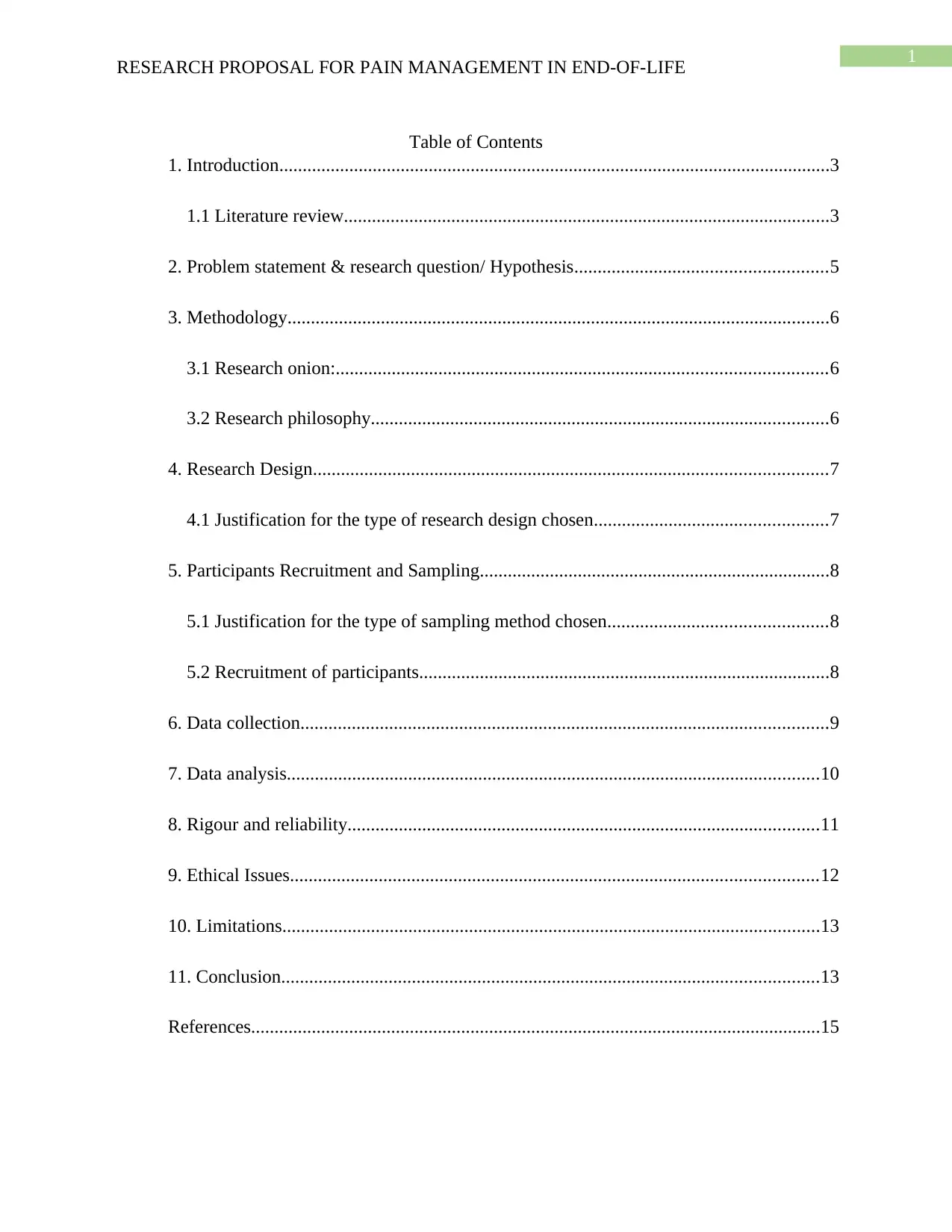
1
RESEARCH PROPOSAL FOR PAIN MANAGEMENT IN END-OF-LIFE
Table of Contents
1. Introduction......................................................................................................................3
1.1 Literature review........................................................................................................3
2. Problem statement & research question/ Hypothesis......................................................5
3. Methodology....................................................................................................................6
3.1 Research onion:.........................................................................................................6
3.2 Research philosophy..................................................................................................6
4. Research Design..............................................................................................................7
4.1 Justification for the type of research design chosen..................................................7
5. Participants Recruitment and Sampling...........................................................................8
5.1 Justification for the type of sampling method chosen...............................................8
5.2 Recruitment of participants........................................................................................8
6. Data collection.................................................................................................................9
7. Data analysis..................................................................................................................10
8. Rigour and reliability.....................................................................................................11
9. Ethical Issues.................................................................................................................12
10. Limitations...................................................................................................................13
11. Conclusion...................................................................................................................13
References..........................................................................................................................15
RESEARCH PROPOSAL FOR PAIN MANAGEMENT IN END-OF-LIFE
Table of Contents
1. Introduction......................................................................................................................3
1.1 Literature review........................................................................................................3
2. Problem statement & research question/ Hypothesis......................................................5
3. Methodology....................................................................................................................6
3.1 Research onion:.........................................................................................................6
3.2 Research philosophy..................................................................................................6
4. Research Design..............................................................................................................7
4.1 Justification for the type of research design chosen..................................................7
5. Participants Recruitment and Sampling...........................................................................8
5.1 Justification for the type of sampling method chosen...............................................8
5.2 Recruitment of participants........................................................................................8
6. Data collection.................................................................................................................9
7. Data analysis..................................................................................................................10
8. Rigour and reliability.....................................................................................................11
9. Ethical Issues.................................................................................................................12
10. Limitations...................................................................................................................13
11. Conclusion...................................................................................................................13
References..........................................................................................................................15

2
RESEARCH PROPOSAL FOR PAIN MANAGEMENT IN END-OF-LIFE
RESEARCH PROPOSAL FOR PAIN MANAGEMENT IN END-OF-LIFE
⊘ This is a preview!⊘
Do you want full access?
Subscribe today to unlock all pages.

Trusted by 1+ million students worldwide
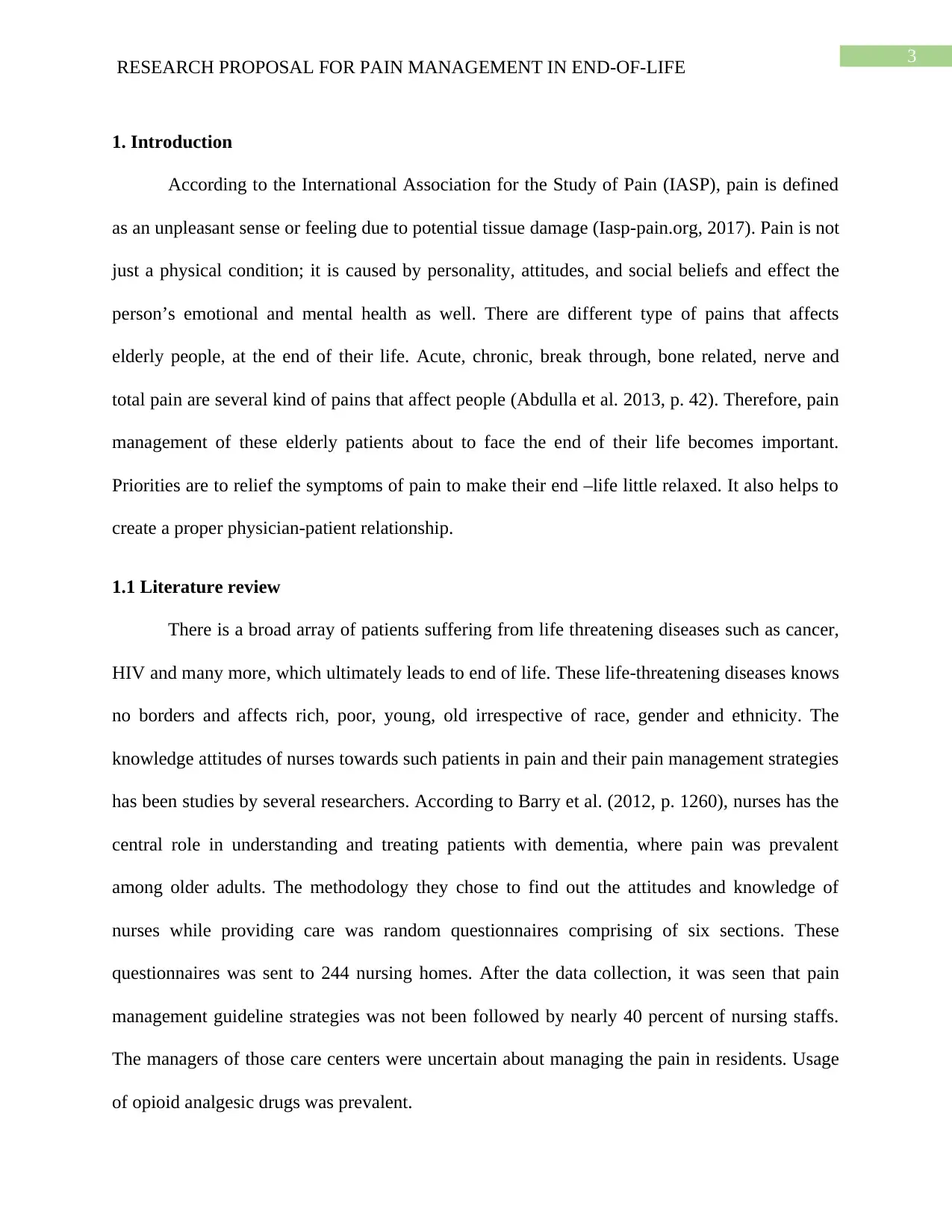
3
RESEARCH PROPOSAL FOR PAIN MANAGEMENT IN END-OF-LIFE
1. Introduction
According to the International Association for the Study of Pain (IASP), pain is defined
as an unpleasant sense or feeling due to potential tissue damage (Iasp-pain.org, 2017). Pain is not
just a physical condition; it is caused by personality, attitudes, and social beliefs and effect the
person’s emotional and mental health as well. There are different type of pains that affects
elderly people, at the end of their life. Acute, chronic, break through, bone related, nerve and
total pain are several kind of pains that affect people (Abdulla et al. 2013, p. 42). Therefore, pain
management of these elderly patients about to face the end of their life becomes important.
Priorities are to relief the symptoms of pain to make their end –life little relaxed. It also helps to
create a proper physician-patient relationship.
1.1 Literature review
There is a broad array of patients suffering from life threatening diseases such as cancer,
HIV and many more, which ultimately leads to end of life. These life-threatening diseases knows
no borders and affects rich, poor, young, old irrespective of race, gender and ethnicity. The
knowledge attitudes of nurses towards such patients in pain and their pain management strategies
has been studies by several researchers. According to Barry et al. (2012, p. 1260), nurses has the
central role in understanding and treating patients with dementia, where pain was prevalent
among older adults. The methodology they chose to find out the attitudes and knowledge of
nurses while providing care was random questionnaires comprising of six sections. These
questionnaires was sent to 244 nursing homes. After the data collection, it was seen that pain
management guideline strategies was not been followed by nearly 40 percent of nursing staffs.
The managers of those care centers were uncertain about managing the pain in residents. Usage
of opioid analgesic drugs was prevalent.
RESEARCH PROPOSAL FOR PAIN MANAGEMENT IN END-OF-LIFE
1. Introduction
According to the International Association for the Study of Pain (IASP), pain is defined
as an unpleasant sense or feeling due to potential tissue damage (Iasp-pain.org, 2017). Pain is not
just a physical condition; it is caused by personality, attitudes, and social beliefs and effect the
person’s emotional and mental health as well. There are different type of pains that affects
elderly people, at the end of their life. Acute, chronic, break through, bone related, nerve and
total pain are several kind of pains that affect people (Abdulla et al. 2013, p. 42). Therefore, pain
management of these elderly patients about to face the end of their life becomes important.
Priorities are to relief the symptoms of pain to make their end –life little relaxed. It also helps to
create a proper physician-patient relationship.
1.1 Literature review
There is a broad array of patients suffering from life threatening diseases such as cancer,
HIV and many more, which ultimately leads to end of life. These life-threatening diseases knows
no borders and affects rich, poor, young, old irrespective of race, gender and ethnicity. The
knowledge attitudes of nurses towards such patients in pain and their pain management strategies
has been studies by several researchers. According to Barry et al. (2012, p. 1260), nurses has the
central role in understanding and treating patients with dementia, where pain was prevalent
among older adults. The methodology they chose to find out the attitudes and knowledge of
nurses while providing care was random questionnaires comprising of six sections. These
questionnaires was sent to 244 nursing homes. After the data collection, it was seen that pain
management guideline strategies was not been followed by nearly 40 percent of nursing staffs.
The managers of those care centers were uncertain about managing the pain in residents. Usage
of opioid analgesic drugs was prevalent.
Paraphrase This Document
Need a fresh take? Get an instant paraphrase of this document with our AI Paraphraser
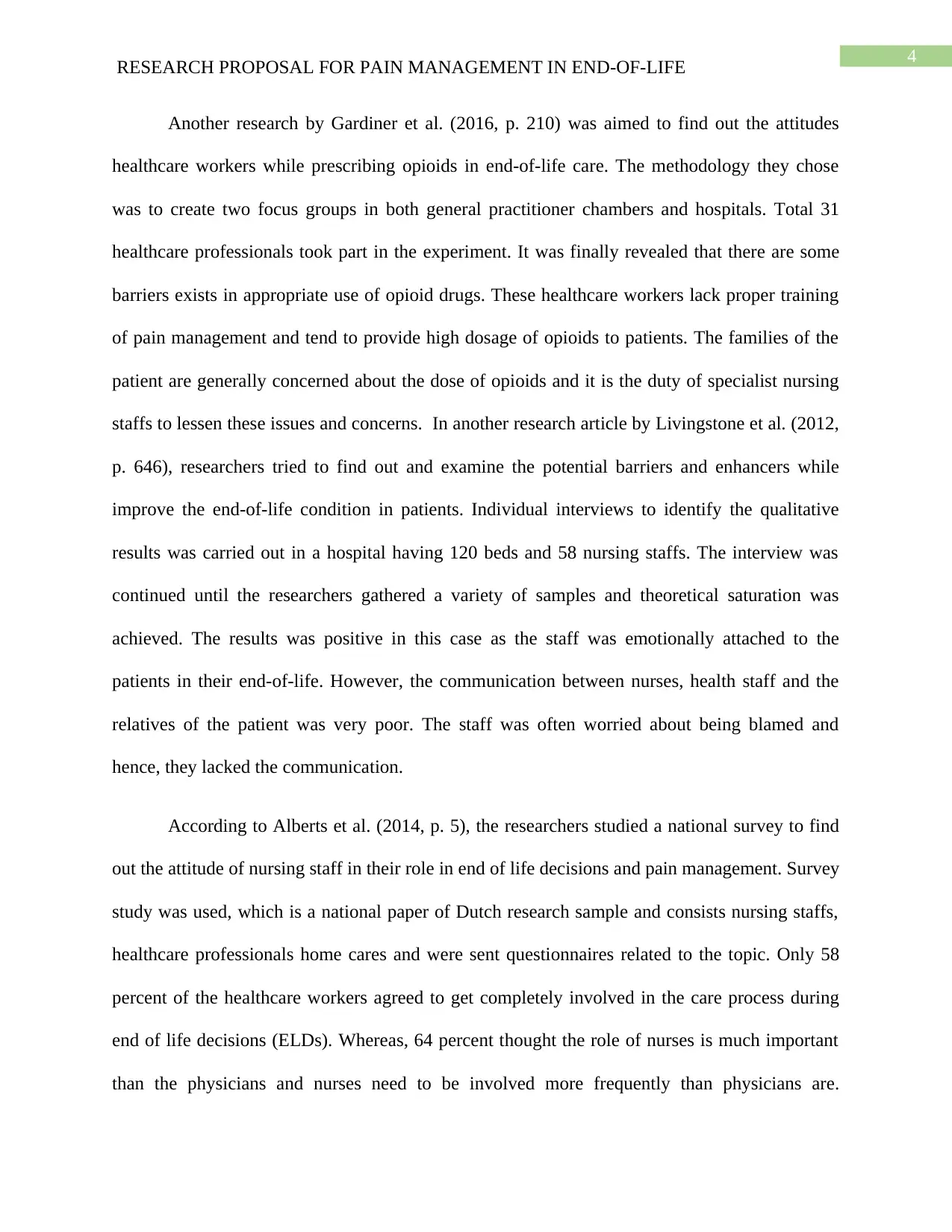
4
RESEARCH PROPOSAL FOR PAIN MANAGEMENT IN END-OF-LIFE
Another research by Gardiner et al. (2016, p. 210) was aimed to find out the attitudes
healthcare workers while prescribing opioids in end-of-life care. The methodology they chose
was to create two focus groups in both general practitioner chambers and hospitals. Total 31
healthcare professionals took part in the experiment. It was finally revealed that there are some
barriers exists in appropriate use of opioid drugs. These healthcare workers lack proper training
of pain management and tend to provide high dosage of opioids to patients. The families of the
patient are generally concerned about the dose of opioids and it is the duty of specialist nursing
staffs to lessen these issues and concerns. In another research article by Livingstone et al. (2012,
p. 646), researchers tried to find out and examine the potential barriers and enhancers while
improve the end-of-life condition in patients. Individual interviews to identify the qualitative
results was carried out in a hospital having 120 beds and 58 nursing staffs. The interview was
continued until the researchers gathered a variety of samples and theoretical saturation was
achieved. The results was positive in this case as the staff was emotionally attached to the
patients in their end-of-life. However, the communication between nurses, health staff and the
relatives of the patient was very poor. The staff was often worried about being blamed and
hence, they lacked the communication.
According to Alberts et al. (2014, p. 5), the researchers studied a national survey to find
out the attitude of nursing staff in their role in end of life decisions and pain management. Survey
study was used, which is a national paper of Dutch research sample and consists nursing staffs,
healthcare professionals home cares and were sent questionnaires related to the topic. Only 58
percent of the healthcare workers agreed to get completely involved in the care process during
end of life decisions (ELDs). Whereas, 64 percent thought the role of nurses is much important
than the physicians and nurses need to be involved more frequently than physicians are.
RESEARCH PROPOSAL FOR PAIN MANAGEMENT IN END-OF-LIFE
Another research by Gardiner et al. (2016, p. 210) was aimed to find out the attitudes
healthcare workers while prescribing opioids in end-of-life care. The methodology they chose
was to create two focus groups in both general practitioner chambers and hospitals. Total 31
healthcare professionals took part in the experiment. It was finally revealed that there are some
barriers exists in appropriate use of opioid drugs. These healthcare workers lack proper training
of pain management and tend to provide high dosage of opioids to patients. The families of the
patient are generally concerned about the dose of opioids and it is the duty of specialist nursing
staffs to lessen these issues and concerns. In another research article by Livingstone et al. (2012,
p. 646), researchers tried to find out and examine the potential barriers and enhancers while
improve the end-of-life condition in patients. Individual interviews to identify the qualitative
results was carried out in a hospital having 120 beds and 58 nursing staffs. The interview was
continued until the researchers gathered a variety of samples and theoretical saturation was
achieved. The results was positive in this case as the staff was emotionally attached to the
patients in their end-of-life. However, the communication between nurses, health staff and the
relatives of the patient was very poor. The staff was often worried about being blamed and
hence, they lacked the communication.
According to Alberts et al. (2014, p. 5), the researchers studied a national survey to find
out the attitude of nursing staff in their role in end of life decisions and pain management. Survey
study was used, which is a national paper of Dutch research sample and consists nursing staffs,
healthcare professionals home cares and were sent questionnaires related to the topic. Only 58
percent of the healthcare workers agreed to get completely involved in the care process during
end of life decisions (ELDs). Whereas, 64 percent thought the role of nurses is much important
than the physicians and nurses need to be involved more frequently than physicians are.
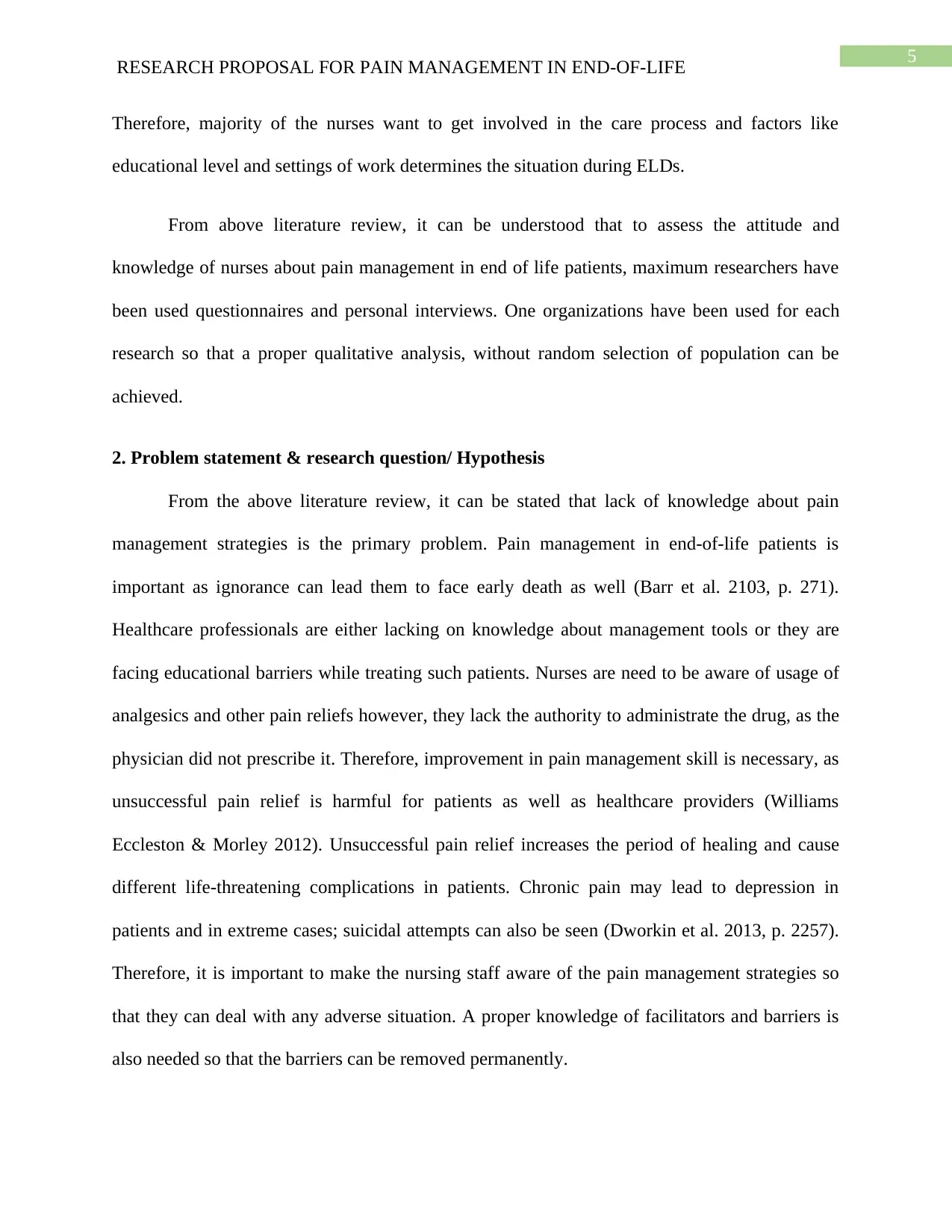
5
RESEARCH PROPOSAL FOR PAIN MANAGEMENT IN END-OF-LIFE
Therefore, majority of the nurses want to get involved in the care process and factors like
educational level and settings of work determines the situation during ELDs.
From above literature review, it can be understood that to assess the attitude and
knowledge of nurses about pain management in end of life patients, maximum researchers have
been used questionnaires and personal interviews. One organizations have been used for each
research so that a proper qualitative analysis, without random selection of population can be
achieved.
2. Problem statement & research question/ Hypothesis
From the above literature review, it can be stated that lack of knowledge about pain
management strategies is the primary problem. Pain management in end-of-life patients is
important as ignorance can lead them to face early death as well (Barr et al. 2103, p. 271).
Healthcare professionals are either lacking on knowledge about management tools or they are
facing educational barriers while treating such patients. Nurses are need to be aware of usage of
analgesics and other pain reliefs however, they lack the authority to administrate the drug, as the
physician did not prescribe it. Therefore, improvement in pain management skill is necessary, as
unsuccessful pain relief is harmful for patients as well as healthcare providers (Williams
Eccleston & Morley 2012). Unsuccessful pain relief increases the period of healing and cause
different life-threatening complications in patients. Chronic pain may lead to depression in
patients and in extreme cases; suicidal attempts can also be seen (Dworkin et al. 2013, p. 2257).
Therefore, it is important to make the nursing staff aware of the pain management strategies so
that they can deal with any adverse situation. A proper knowledge of facilitators and barriers is
also needed so that the barriers can be removed permanently.
RESEARCH PROPOSAL FOR PAIN MANAGEMENT IN END-OF-LIFE
Therefore, majority of the nurses want to get involved in the care process and factors like
educational level and settings of work determines the situation during ELDs.
From above literature review, it can be understood that to assess the attitude and
knowledge of nurses about pain management in end of life patients, maximum researchers have
been used questionnaires and personal interviews. One organizations have been used for each
research so that a proper qualitative analysis, without random selection of population can be
achieved.
2. Problem statement & research question/ Hypothesis
From the above literature review, it can be stated that lack of knowledge about pain
management strategies is the primary problem. Pain management in end-of-life patients is
important as ignorance can lead them to face early death as well (Barr et al. 2103, p. 271).
Healthcare professionals are either lacking on knowledge about management tools or they are
facing educational barriers while treating such patients. Nurses are need to be aware of usage of
analgesics and other pain reliefs however, they lack the authority to administrate the drug, as the
physician did not prescribe it. Therefore, improvement in pain management skill is necessary, as
unsuccessful pain relief is harmful for patients as well as healthcare providers (Williams
Eccleston & Morley 2012). Unsuccessful pain relief increases the period of healing and cause
different life-threatening complications in patients. Chronic pain may lead to depression in
patients and in extreme cases; suicidal attempts can also be seen (Dworkin et al. 2013, p. 2257).
Therefore, it is important to make the nursing staff aware of the pain management strategies so
that they can deal with any adverse situation. A proper knowledge of facilitators and barriers is
also needed so that the barriers can be removed permanently.
⊘ This is a preview!⊘
Do you want full access?
Subscribe today to unlock all pages.

Trusted by 1+ million students worldwide
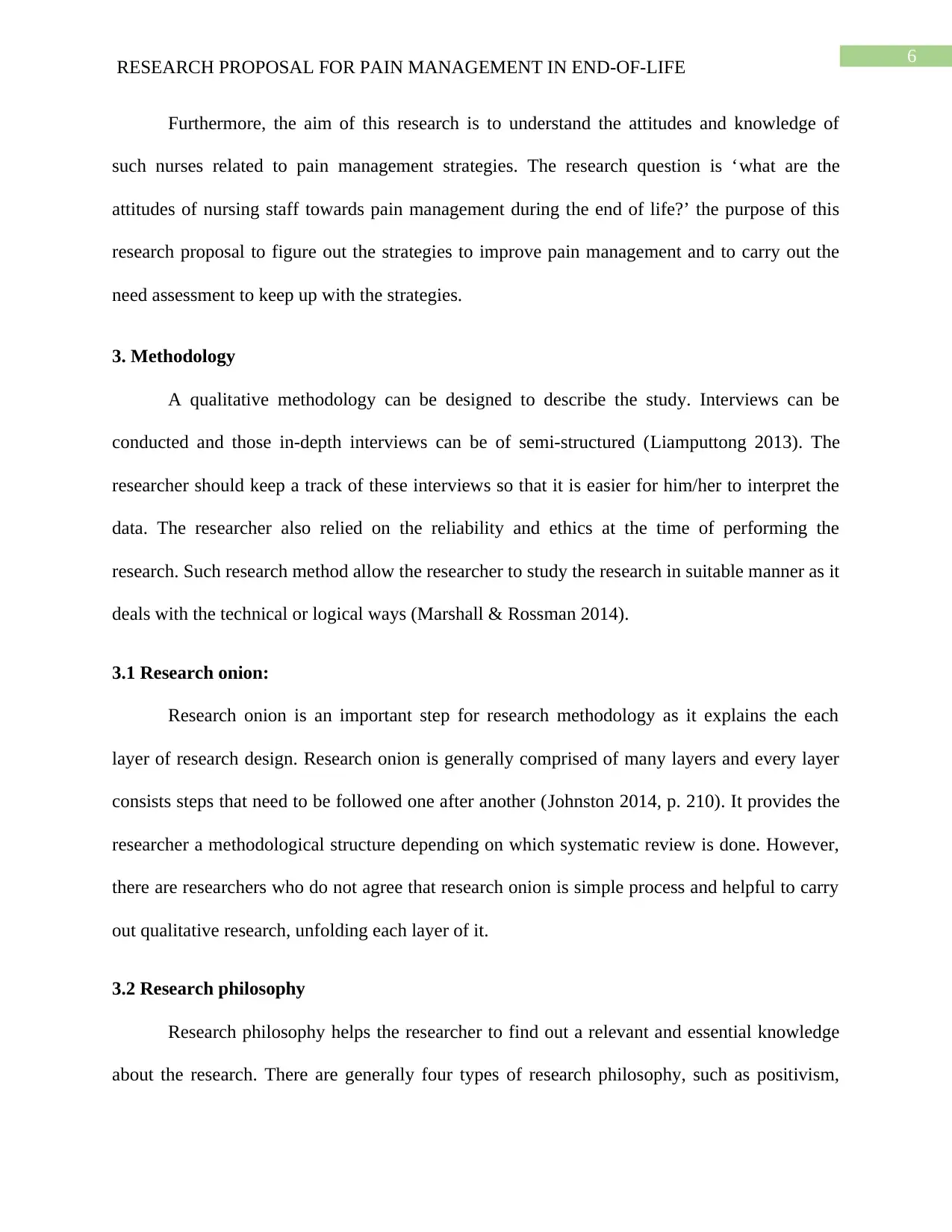
6
RESEARCH PROPOSAL FOR PAIN MANAGEMENT IN END-OF-LIFE
Furthermore, the aim of this research is to understand the attitudes and knowledge of
such nurses related to pain management strategies. The research question is ‘what are the
attitudes of nursing staff towards pain management during the end of life?’ the purpose of this
research proposal to figure out the strategies to improve pain management and to carry out the
need assessment to keep up with the strategies.
3. Methodology
A qualitative methodology can be designed to describe the study. Interviews can be
conducted and those in-depth interviews can be of semi-structured (Liamputtong 2013). The
researcher should keep a track of these interviews so that it is easier for him/her to interpret the
data. The researcher also relied on the reliability and ethics at the time of performing the
research. Such research method allow the researcher to study the research in suitable manner as it
deals with the technical or logical ways (Marshall & Rossman 2014).
3.1 Research onion:
Research onion is an important step for research methodology as it explains the each
layer of research design. Research onion is generally comprised of many layers and every layer
consists steps that need to be followed one after another (Johnston 2014, p. 210). It provides the
researcher a methodological structure depending on which systematic review is done. However,
there are researchers who do not agree that research onion is simple process and helpful to carry
out qualitative research, unfolding each layer of it.
3.2 Research philosophy
Research philosophy helps the researcher to find out a relevant and essential knowledge
about the research. There are generally four types of research philosophy, such as positivism,
RESEARCH PROPOSAL FOR PAIN MANAGEMENT IN END-OF-LIFE
Furthermore, the aim of this research is to understand the attitudes and knowledge of
such nurses related to pain management strategies. The research question is ‘what are the
attitudes of nursing staff towards pain management during the end of life?’ the purpose of this
research proposal to figure out the strategies to improve pain management and to carry out the
need assessment to keep up with the strategies.
3. Methodology
A qualitative methodology can be designed to describe the study. Interviews can be
conducted and those in-depth interviews can be of semi-structured (Liamputtong 2013). The
researcher should keep a track of these interviews so that it is easier for him/her to interpret the
data. The researcher also relied on the reliability and ethics at the time of performing the
research. Such research method allow the researcher to study the research in suitable manner as it
deals with the technical or logical ways (Marshall & Rossman 2014).
3.1 Research onion:
Research onion is an important step for research methodology as it explains the each
layer of research design. Research onion is generally comprised of many layers and every layer
consists steps that need to be followed one after another (Johnston 2014, p. 210). It provides the
researcher a methodological structure depending on which systematic review is done. However,
there are researchers who do not agree that research onion is simple process and helpful to carry
out qualitative research, unfolding each layer of it.
3.2 Research philosophy
Research philosophy helps the researcher to find out a relevant and essential knowledge
about the research. There are generally four types of research philosophy, such as positivism,
Paraphrase This Document
Need a fresh take? Get an instant paraphrase of this document with our AI Paraphraser
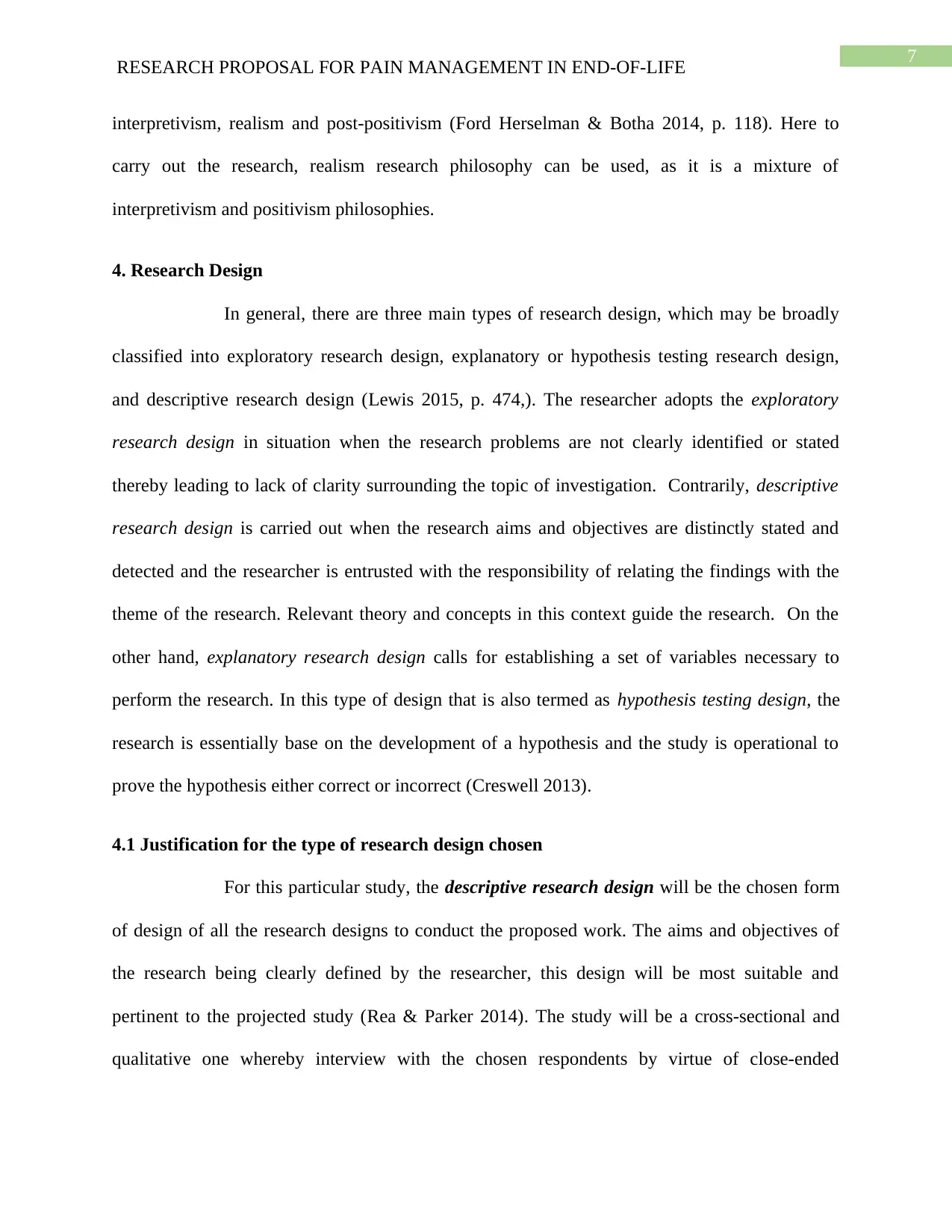
7
RESEARCH PROPOSAL FOR PAIN MANAGEMENT IN END-OF-LIFE
interpretivism, realism and post-positivism (Ford Herselman & Botha 2014, p. 118). Here to
carry out the research, realism research philosophy can be used, as it is a mixture of
interpretivism and positivism philosophies.
4. Research Design
In general, there are three main types of research design, which may be broadly
classified into exploratory research design, explanatory or hypothesis testing research design,
and descriptive research design (Lewis 2015, p. 474,). The researcher adopts the exploratory
research design in situation when the research problems are not clearly identified or stated
thereby leading to lack of clarity surrounding the topic of investigation. Contrarily, descriptive
research design is carried out when the research aims and objectives are distinctly stated and
detected and the researcher is entrusted with the responsibility of relating the findings with the
theme of the research. Relevant theory and concepts in this context guide the research. On the
other hand, explanatory research design calls for establishing a set of variables necessary to
perform the research. In this type of design that is also termed as hypothesis testing design, the
research is essentially base on the development of a hypothesis and the study is operational to
prove the hypothesis either correct or incorrect (Creswell 2013).
4.1 Justification for the type of research design chosen
For this particular study, the descriptive research design will be the chosen form
of design of all the research designs to conduct the proposed work. The aims and objectives of
the research being clearly defined by the researcher, this design will be most suitable and
pertinent to the projected study (Rea & Parker 2014). The study will be a cross-sectional and
qualitative one whereby interview with the chosen respondents by virtue of close-ended
RESEARCH PROPOSAL FOR PAIN MANAGEMENT IN END-OF-LIFE
interpretivism, realism and post-positivism (Ford Herselman & Botha 2014, p. 118). Here to
carry out the research, realism research philosophy can be used, as it is a mixture of
interpretivism and positivism philosophies.
4. Research Design
In general, there are three main types of research design, which may be broadly
classified into exploratory research design, explanatory or hypothesis testing research design,
and descriptive research design (Lewis 2015, p. 474,). The researcher adopts the exploratory
research design in situation when the research problems are not clearly identified or stated
thereby leading to lack of clarity surrounding the topic of investigation. Contrarily, descriptive
research design is carried out when the research aims and objectives are distinctly stated and
detected and the researcher is entrusted with the responsibility of relating the findings with the
theme of the research. Relevant theory and concepts in this context guide the research. On the
other hand, explanatory research design calls for establishing a set of variables necessary to
perform the research. In this type of design that is also termed as hypothesis testing design, the
research is essentially base on the development of a hypothesis and the study is operational to
prove the hypothesis either correct or incorrect (Creswell 2013).
4.1 Justification for the type of research design chosen
For this particular study, the descriptive research design will be the chosen form
of design of all the research designs to conduct the proposed work. The aims and objectives of
the research being clearly defined by the researcher, this design will be most suitable and
pertinent to the projected study (Rea & Parker 2014). The study will be a cross-sectional and
qualitative one whereby interview with the chosen respondents by virtue of close-ended

8
RESEARCH PROPOSAL FOR PAIN MANAGEMENT IN END-OF-LIFE
questionnaire will aid in emanation of definite themes for clearly elucidating the chosen topic of
research.
RESEARCH PROPOSAL FOR PAIN MANAGEMENT IN END-OF-LIFE
questionnaire will aid in emanation of definite themes for clearly elucidating the chosen topic of
research.
⊘ This is a preview!⊘
Do you want full access?
Subscribe today to unlock all pages.

Trusted by 1+ million students worldwide
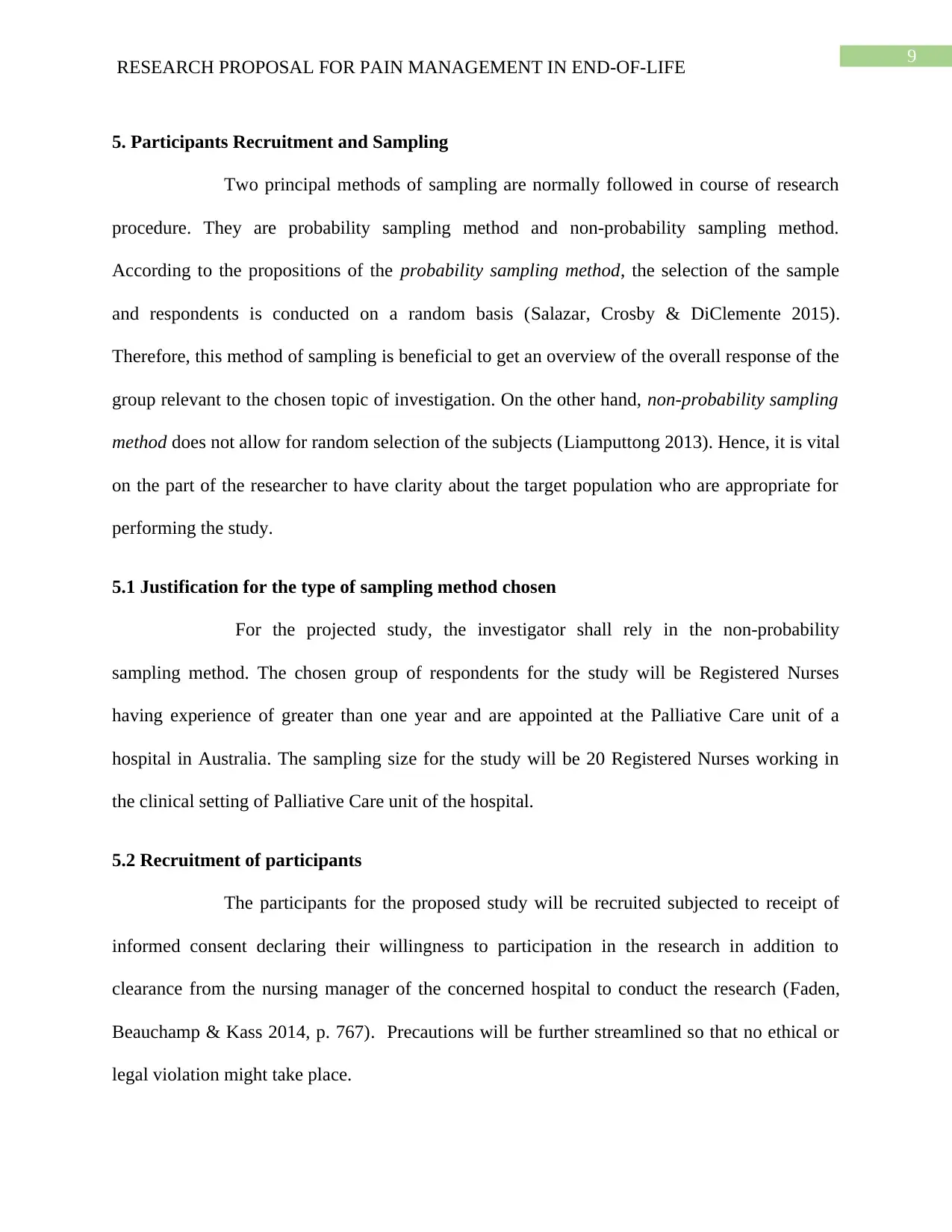
9
RESEARCH PROPOSAL FOR PAIN MANAGEMENT IN END-OF-LIFE
5. Participants Recruitment and Sampling
Two principal methods of sampling are normally followed in course of research
procedure. They are probability sampling method and non-probability sampling method.
According to the propositions of the probability sampling method, the selection of the sample
and respondents is conducted on a random basis (Salazar, Crosby & DiClemente 2015).
Therefore, this method of sampling is beneficial to get an overview of the overall response of the
group relevant to the chosen topic of investigation. On the other hand, non-probability sampling
method does not allow for random selection of the subjects (Liamputtong 2013). Hence, it is vital
on the part of the researcher to have clarity about the target population who are appropriate for
performing the study.
5.1 Justification for the type of sampling method chosen
For the projected study, the investigator shall rely in the non-probability
sampling method. The chosen group of respondents for the study will be Registered Nurses
having experience of greater than one year and are appointed at the Palliative Care unit of a
hospital in Australia. The sampling size for the study will be 20 Registered Nurses working in
the clinical setting of Palliative Care unit of the hospital.
5.2 Recruitment of participants
The participants for the proposed study will be recruited subjected to receipt of
informed consent declaring their willingness to participation in the research in addition to
clearance from the nursing manager of the concerned hospital to conduct the research (Faden,
Beauchamp & Kass 2014, p. 767). Precautions will be further streamlined so that no ethical or
legal violation might take place.
RESEARCH PROPOSAL FOR PAIN MANAGEMENT IN END-OF-LIFE
5. Participants Recruitment and Sampling
Two principal methods of sampling are normally followed in course of research
procedure. They are probability sampling method and non-probability sampling method.
According to the propositions of the probability sampling method, the selection of the sample
and respondents is conducted on a random basis (Salazar, Crosby & DiClemente 2015).
Therefore, this method of sampling is beneficial to get an overview of the overall response of the
group relevant to the chosen topic of investigation. On the other hand, non-probability sampling
method does not allow for random selection of the subjects (Liamputtong 2013). Hence, it is vital
on the part of the researcher to have clarity about the target population who are appropriate for
performing the study.
5.1 Justification for the type of sampling method chosen
For the projected study, the investigator shall rely in the non-probability
sampling method. The chosen group of respondents for the study will be Registered Nurses
having experience of greater than one year and are appointed at the Palliative Care unit of a
hospital in Australia. The sampling size for the study will be 20 Registered Nurses working in
the clinical setting of Palliative Care unit of the hospital.
5.2 Recruitment of participants
The participants for the proposed study will be recruited subjected to receipt of
informed consent declaring their willingness to participation in the research in addition to
clearance from the nursing manager of the concerned hospital to conduct the research (Faden,
Beauchamp & Kass 2014, p. 767). Precautions will be further streamlined so that no ethical or
legal violation might take place.
Paraphrase This Document
Need a fresh take? Get an instant paraphrase of this document with our AI Paraphraser
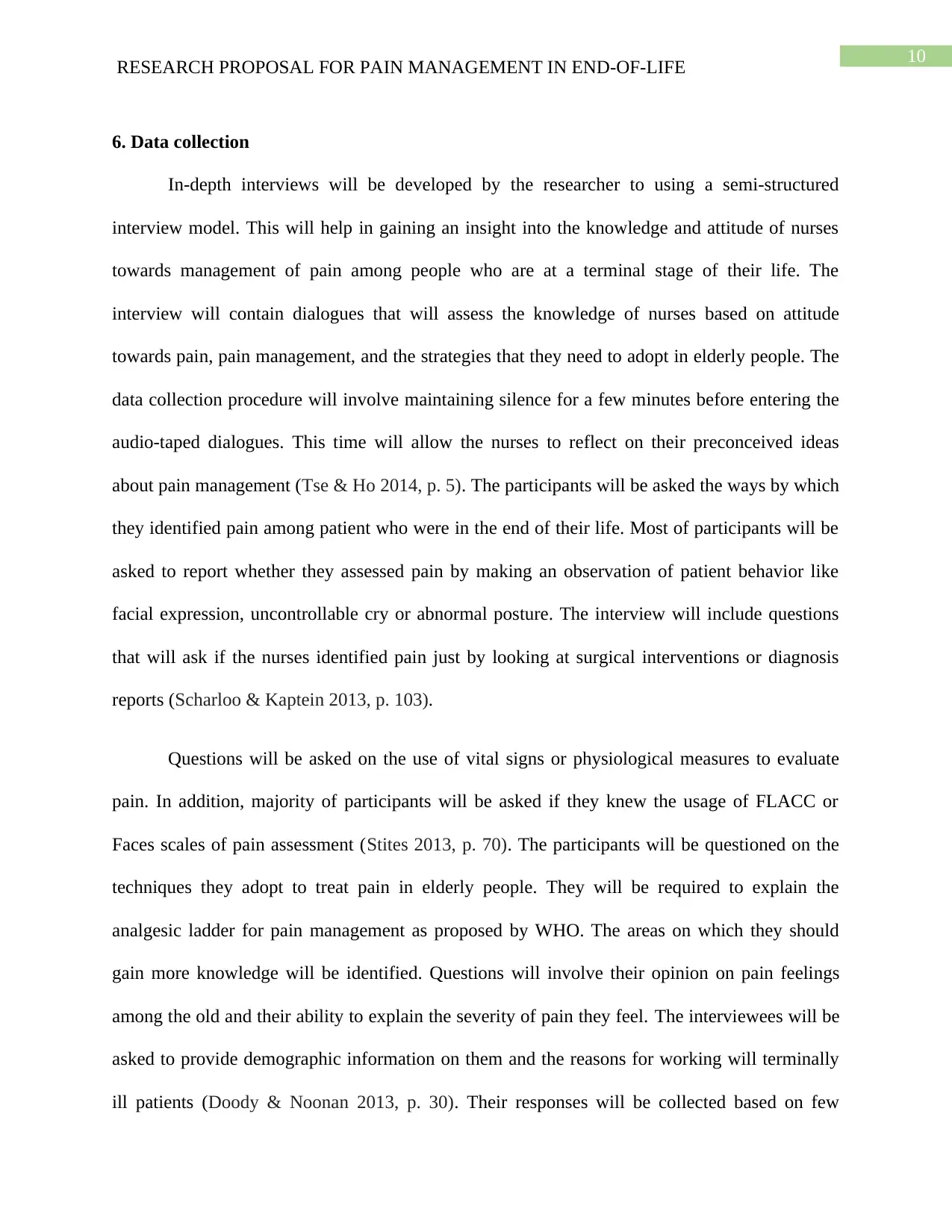
10
RESEARCH PROPOSAL FOR PAIN MANAGEMENT IN END-OF-LIFE
6. Data collection
In-depth interviews will be developed by the researcher to using a semi-structured
interview model. This will help in gaining an insight into the knowledge and attitude of nurses
towards management of pain among people who are at a terminal stage of their life. The
interview will contain dialogues that will assess the knowledge of nurses based on attitude
towards pain, pain management, and the strategies that they need to adopt in elderly people. The
data collection procedure will involve maintaining silence for a few minutes before entering the
audio-taped dialogues. This time will allow the nurses to reflect on their preconceived ideas
about pain management (Tse & Ho 2014, p. 5). The participants will be asked the ways by which
they identified pain among patient who were in the end of their life. Most of participants will be
asked to report whether they assessed pain by making an observation of patient behavior like
facial expression, uncontrollable cry or abnormal posture. The interview will include questions
that will ask if the nurses identified pain just by looking at surgical interventions or diagnosis
reports (Scharloo & Kaptein 2013, p. 103).
Questions will be asked on the use of vital signs or physiological measures to evaluate
pain. In addition, majority of participants will be asked if they knew the usage of FLACC or
Faces scales of pain assessment (Stites 2013, p. 70). The participants will be questioned on the
techniques they adopt to treat pain in elderly people. They will be required to explain the
analgesic ladder for pain management as proposed by WHO. The areas on which they should
gain more knowledge will be identified. Questions will involve their opinion on pain feelings
among the old and their ability to explain the severity of pain they feel. The interviewees will be
asked to provide demographic information on them and the reasons for working will terminally
ill patients (Doody & Noonan 2013, p. 30). Their responses will be collected based on few
RESEARCH PROPOSAL FOR PAIN MANAGEMENT IN END-OF-LIFE
6. Data collection
In-depth interviews will be developed by the researcher to using a semi-structured
interview model. This will help in gaining an insight into the knowledge and attitude of nurses
towards management of pain among people who are at a terminal stage of their life. The
interview will contain dialogues that will assess the knowledge of nurses based on attitude
towards pain, pain management, and the strategies that they need to adopt in elderly people. The
data collection procedure will involve maintaining silence for a few minutes before entering the
audio-taped dialogues. This time will allow the nurses to reflect on their preconceived ideas
about pain management (Tse & Ho 2014, p. 5). The participants will be asked the ways by which
they identified pain among patient who were in the end of their life. Most of participants will be
asked to report whether they assessed pain by making an observation of patient behavior like
facial expression, uncontrollable cry or abnormal posture. The interview will include questions
that will ask if the nurses identified pain just by looking at surgical interventions or diagnosis
reports (Scharloo & Kaptein 2013, p. 103).
Questions will be asked on the use of vital signs or physiological measures to evaluate
pain. In addition, majority of participants will be asked if they knew the usage of FLACC or
Faces scales of pain assessment (Stites 2013, p. 70). The participants will be questioned on the
techniques they adopt to treat pain in elderly people. They will be required to explain the
analgesic ladder for pain management as proposed by WHO. The areas on which they should
gain more knowledge will be identified. Questions will involve their opinion on pain feelings
among the old and their ability to explain the severity of pain they feel. The interviewees will be
asked to provide demographic information on them and the reasons for working will terminally
ill patients (Doody & Noonan 2013, p. 30). Their responses will be collected based on few
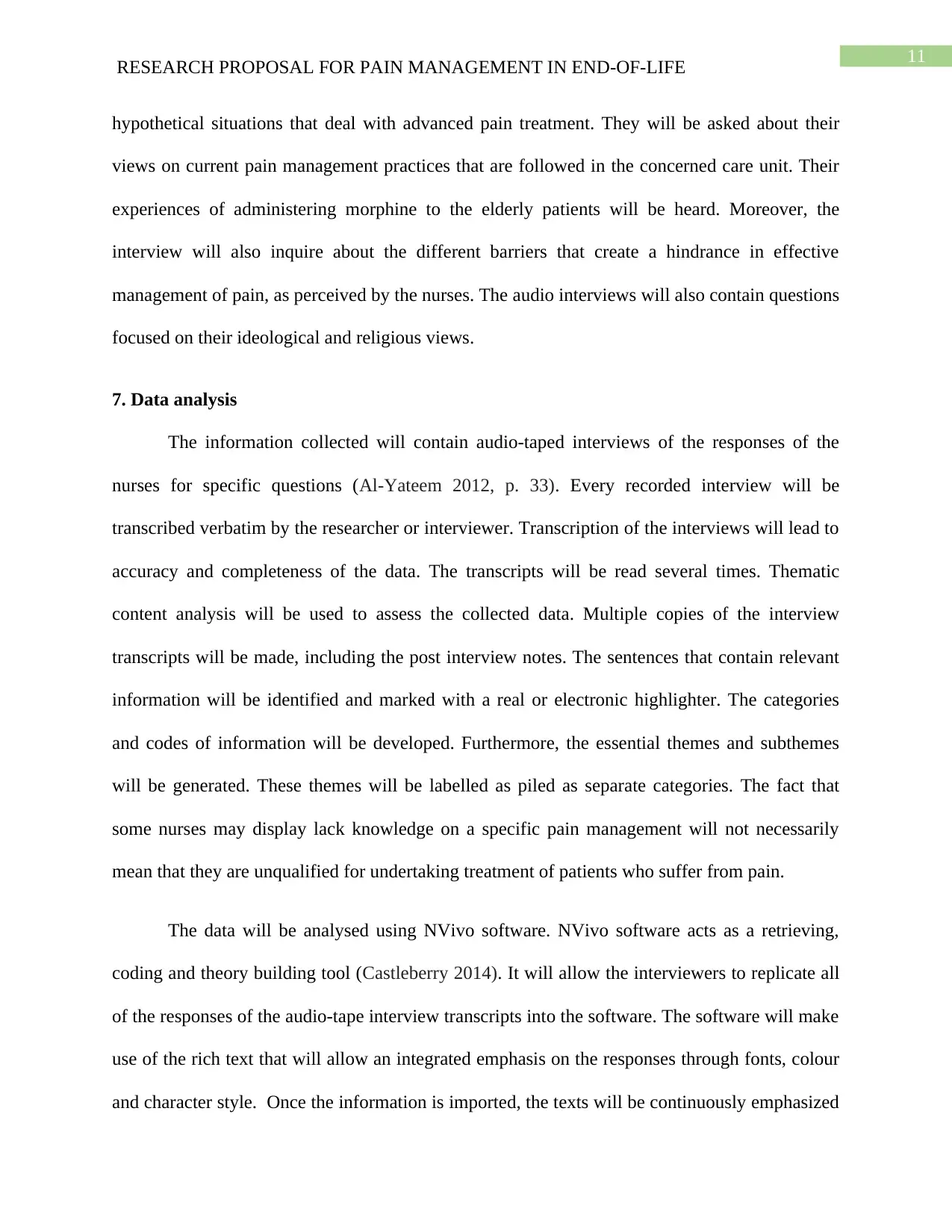
11
RESEARCH PROPOSAL FOR PAIN MANAGEMENT IN END-OF-LIFE
hypothetical situations that deal with advanced pain treatment. They will be asked about their
views on current pain management practices that are followed in the concerned care unit. Their
experiences of administering morphine to the elderly patients will be heard. Moreover, the
interview will also inquire about the different barriers that create a hindrance in effective
management of pain, as perceived by the nurses. The audio interviews will also contain questions
focused on their ideological and religious views.
7. Data analysis
The information collected will contain audio-taped interviews of the responses of the
nurses for specific questions (Al-Yateem 2012, p. 33). Every recorded interview will be
transcribed verbatim by the researcher or interviewer. Transcription of the interviews will lead to
accuracy and completeness of the data. The transcripts will be read several times. Thematic
content analysis will be used to assess the collected data. Multiple copies of the interview
transcripts will be made, including the post interview notes. The sentences that contain relevant
information will be identified and marked with a real or electronic highlighter. The categories
and codes of information will be developed. Furthermore, the essential themes and subthemes
will be generated. These themes will be labelled as piled as separate categories. The fact that
some nurses may display lack knowledge on a specific pain management will not necessarily
mean that they are unqualified for undertaking treatment of patients who suffer from pain.
The data will be analysed using NVivo software. NVivo software acts as a retrieving,
coding and theory building tool (Castleberry 2014). It will allow the interviewers to replicate all
of the responses of the audio-tape interview transcripts into the software. The software will make
use of the rich text that will allow an integrated emphasis on the responses through fonts, colour
and character style. Once the information is imported, the texts will be continuously emphasized
RESEARCH PROPOSAL FOR PAIN MANAGEMENT IN END-OF-LIFE
hypothetical situations that deal with advanced pain treatment. They will be asked about their
views on current pain management practices that are followed in the concerned care unit. Their
experiences of administering morphine to the elderly patients will be heard. Moreover, the
interview will also inquire about the different barriers that create a hindrance in effective
management of pain, as perceived by the nurses. The audio interviews will also contain questions
focused on their ideological and religious views.
7. Data analysis
The information collected will contain audio-taped interviews of the responses of the
nurses for specific questions (Al-Yateem 2012, p. 33). Every recorded interview will be
transcribed verbatim by the researcher or interviewer. Transcription of the interviews will lead to
accuracy and completeness of the data. The transcripts will be read several times. Thematic
content analysis will be used to assess the collected data. Multiple copies of the interview
transcripts will be made, including the post interview notes. The sentences that contain relevant
information will be identified and marked with a real or electronic highlighter. The categories
and codes of information will be developed. Furthermore, the essential themes and subthemes
will be generated. These themes will be labelled as piled as separate categories. The fact that
some nurses may display lack knowledge on a specific pain management will not necessarily
mean that they are unqualified for undertaking treatment of patients who suffer from pain.
The data will be analysed using NVivo software. NVivo software acts as a retrieving,
coding and theory building tool (Castleberry 2014). It will allow the interviewers to replicate all
of the responses of the audio-tape interview transcripts into the software. The software will make
use of the rich text that will allow an integrated emphasis on the responses through fonts, colour
and character style. Once the information is imported, the texts will be continuously emphasized
⊘ This is a preview!⊘
Do you want full access?
Subscribe today to unlock all pages.

Trusted by 1+ million students worldwide
1 out of 20
Related Documents
Your All-in-One AI-Powered Toolkit for Academic Success.
+13062052269
info@desklib.com
Available 24*7 on WhatsApp / Email
![[object Object]](/_next/static/media/star-bottom.7253800d.svg)
Unlock your academic potential
Copyright © 2020–2025 A2Z Services. All Rights Reserved. Developed and managed by ZUCOL.





